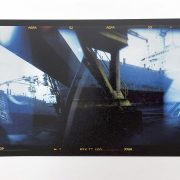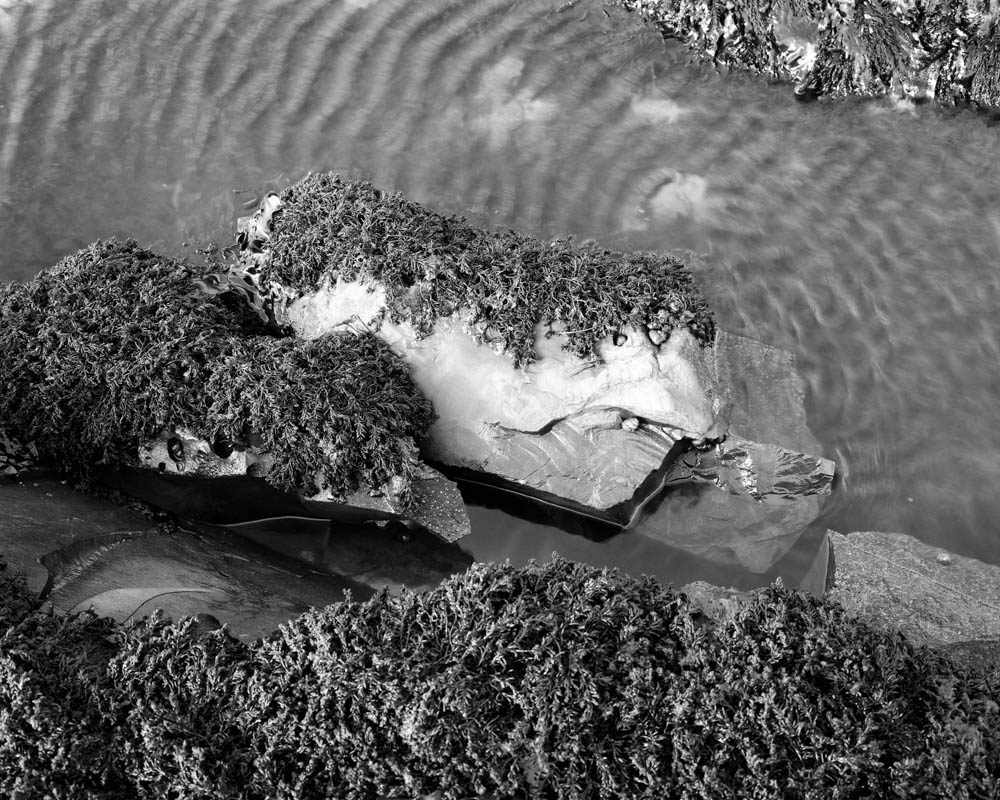Bharat Sikka – AND THEN
It’s not often necessary to begin a review describing the book’s design, but in the case of Bharat Sikka’s AND THEN, knowing that every spread has a generous red margin becomes critical, as this influences our perception of the pictures. I believe it’s impossible, in other words, to remain unaffected by this redness, a high-stakes proposition whose purpose, beyond challenging the viewer’s expectations, remains obtuse. Adding to this surplus of red are the numerous instances where the color is also present in the pictures themselves, blurring the distinction between image and object when the hue bleeds into the margins. If, at this point, you are painfully aware of the color above, you can begin to get an idea of what engaging with this book feels like. The accretion of red is such that the pictures without it, like the close-up of a wrecked white car, feel like a breather.
It’s not often necessary to begin a review describing the book’s design, but in the case of Bharat Sikka’s AND THEN, knowing that every spread has a generous red margin becomes critical, as this influences our perception of the pictures.
AND THEN is the work of a flâneur, but whether Sikka explored a new area or revisited long-favored sites is unclear. Save for a few images that depict the point where the urban landscape ends and the natural one begins, the rest of the spaces featured can be encountered in almost any major city, with Sikka emphasizing urban voids, objects on the ground, and vernacular architecture. But even when tightly composed, some of these feel too casual, like pictures for a mood board prepared by a location scout for a Wim Wenders film. Notwithstanding the bold choice of red margins on a very smelly uncoated paper, the rest of the book’s design is simple. The cardboard cover and exposed spine harmonize with Sikka’s unassuming aesthetic.




Issues of perception are hinted at throughout the sequence, such as in the picture of a tipped-over bollard made of gravel lying next to a rock, two entirely different objects that feel related only because of the way Sikka photographed them. Likewise, a picture of a discarded painting in a dumpster raises questions of representation. Both media have been deployed to aestheticize everyday life, except that Sikka’s photograph shows the environment it belongs to. That may seem like a slight difference, but it highlights the documentary power of photographs to reveal an object’s context, information that can be essential in forming an opinion about it.
Contrary to some of Sikka’s previous publications, which have a discernible perspective on the place they represent … this collection of images doesn’t seem to fulfill a pre-determined program.
The book’s title comes from a sentence on a windshield in Gothic typeface, minus the question mark that gives the sentence in the image an inflection of uncertainty, possibly mirroring Sikka’s own throughout the process of making the work. Words are used more drastically in a picture of an abandoned garage, where a text on the wall reads: “Raise your hands if you want to speak.” The light directs our gaze to the ground, making us participants in a social dynamic where it seems power is not on our side and rules are unquestionable. In a country like South Africa, this mode of interpellation has a loaded history, the kind of tacit discrimination that J.M. Coetzee frequently alludes to in his novels. As a counterbalance, another picture shows the apocryphal Mandela quote, “it always seems impossible until it’s done”. Intriguingly, the optimistic message adorns a mural above a disheveled shack that has seen better days.



Contrary to some of Sikka’s previous publications, which have a discernible perspective on the place they represent – his depiction of Kashmir in Where the Flowers Still Grow comes to mind – this collection of images doesn’t seem to fulfill a pre-determined program. The book doesn’t disclose why, or even where, Sikka made his pictures. Of course, a project’s success cannot be measured solely by considering whether its framework and aims are explicit to the viewer, but perhaps including a short statement and more overt cultural references could have made the book’s raison d’être more discernible. At the very least, AND THEN could have disclosed the location of the pictures. Knowing they were made in Woodstock, a suburb of Cape Town, is essential to understanding their heavy contrast and color saturation, factors that suggest they were made in the same season (or even on the same trip). Unfortunately, interested viewers must consult the publisher’s website to learn this about the work, although not much additional information is available there or on the artist’s website.
The deliberate decision to make the title page the only text in the book, while legitimate, raises many questions that remain unanswered once viewers reach the end of the sequence: What brought Sikka, who lives in Delhi, to South Africa? Why is this location significant for him? Did he have a methodology for making the work, or was his exploration purely instinctual? By not providing any answers, Sikka engages us on a strictly visual level, eschewing any kind of narrative, whether personal, political, or speculative. Taken at face value, AND THEN is a pleasurable book to look at with unusual design choices, but it’s hard to shake the feeling that there was more to explore beneath the surface, a subtext we cannot access, however hard we try.
Bharat Sikka
Fw:Books 2024


















